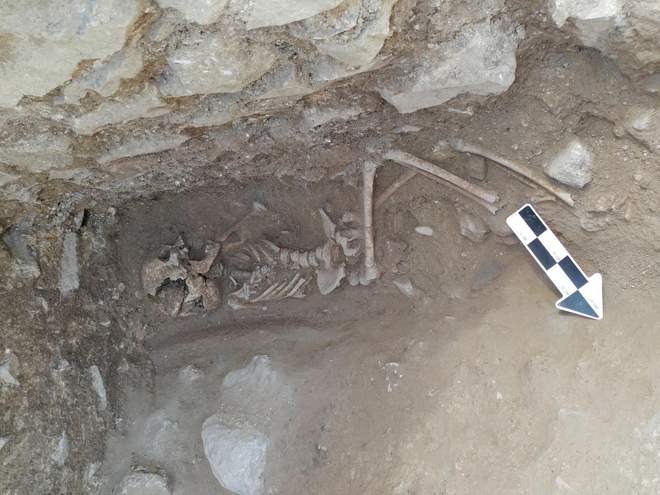‘I’ve never seen anything like it. It’s extremely eerie and weird,’ says archaeologist

A “vampire burial” unearthed at a Roman site in Italy is evidence of ancient funeral practices to stop corpses rising from the dead, according to archaeologists.
The body of a 10-year-old child was buried ritualistically with a stone in its mouth, possibly out of fear it would return to spread disease to its community.
Known locally as the “Vampire of Lugnano”, evidence collected from the bones suggest the child was infected with malaria at the time it died.
“I’ve never seen anything like it. It’s extremely eerie and weird,” said Professor David Soren, an archaeologist at the University of Arizona who has run excavations in the region for over three decades.
The remains are the latest unusual discovery to emerge from the Cemetery of Children, a site containing dozens of children’s bodies and evidence of witchcraft including toad bones, raven talons and bronze cauldrons.
Dated to a time in the fifth century when a deadly malaria outbreak swept across central Italy, archaeologists thought the cemetery had been set aside specifically for the babies and young children who would have been most vulnerable to the disease.
The “vampire” skeleton, which is of unknown sex, is the oldest child to be identified so far at the site.
It was one of five new burials discovered there over the summer, and was found placed underneath a makeshift tomb constructed from roof tiles.
“Knowing that two large roof tiles were used for this burial, I was expecting something unique to be found inside, perhaps a ‘double-inhumation’ – not uncommon for this cemetery – where a single burial contains two individuals,” said David Pickel, a PhD student a Stanford who directed the excavation.
“After removing the roof tiles, however, it became immediately clear to us that we were dealing with an older individual.”
The child’s open jaws and tooth marks on the surface of the stone were evidence that it had been placed in the mouth intentionally.
Similar burials have been documented from Venice to Northamptonshire, and along with dismembering bodies and forcing stakes through the heart are thought to be methods of preventing these “vampires” from returning to haunt the living.
“This is a very unusual mortuary treatment that you see in various forms in different cultures, especially in the Roman world, that could indicate there was a fear that this person might come back from the dead and try to spread disease to the living,” explained bioarchaeologist Jordan Wilson, another PhD student who examined the body.
Professoer Soren added: “We know that the Romans were very much concerned with this and would even go to the extent of employing witchcraft to keep the evil – whatever is contaminating the body – from coming out.”
An abscessed tooth, which can be a side effect of malaria, provided evidence that the child had been killed in the epidemic that struck so many of the cemetery’s inhabitants.
Elsewhere at the site, a three-year-old girl had been buried with stones weighing down her arms and feet – a practice also thought to prevent corpses from returning to life.
The researchers said these practices provide a fascinating insight into the thought processes of ancient Romans and their fears about life after death.
“It’s a very human thing to have complicated feelings about the dead and wonder if that’s really the end,” said Ms Wilson.
“Anytime you can look at burials, they’re significant because they provide a window into ancient minds.”
With much of the cemetery still unexplored, the archaeologists intend to return to the site next summer to complete their excavations.
Complete Article ↪HERE↩!
